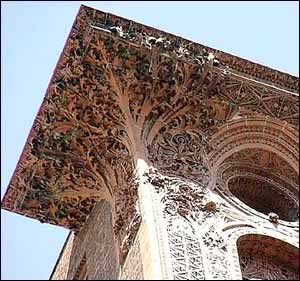
Stairway Balusters a rare example of Louis Sullivan's architectural genius has been placed in one of the most inappropriate places in the entire University of Nebraska, where it goes unappreciated. They are subtly placed in a corner of a ledge where the casual passerby would never even glance at it, which is a pity considering the history of Sullivan pieces. In short, Louis Sullivan was considered to be a maverick of his time. With his unique natural and ge ometric motifs reflecting the interior of the building and the invention of the modern day skyscraper, Sullivan became known as the father of modernism. His architecture inspired a group of aspiring architects to open the Prairie School, with Sullivan as inspiration, as well as influencing and teaching several well known architects including Frank Lloyd Wright. Unfortunately after the World War II there was a movement known as the urban renewal, influencing the government to demolish several of Sullivan's buildings and small architectural pieces. The Stairway Balusters were created to adorn the facade of the Schlesinger & Mayer Department Store in Chicago, but during the urban renewal the balusters were removed during the remodeling. They were fortunately saved and given to the Institute of Art in Chicago, where they stayed until they were donated to the University of Nebraska-Lincoln.
ometric motifs reflecting the interior of the building and the invention of the modern day skyscraper, Sullivan became known as the father of modernism. His architecture inspired a group of aspiring architects to open the Prairie School, with Sullivan as inspiration, as well as influencing and teaching several well known architects including Frank Lloyd Wright. Unfortunately after the World War II there was a movement known as the urban renewal, influencing the government to demolish several of Sullivan's buildings and small architectural pieces. The Stairway Balusters were created to adorn the facade of the Schlesinger & Mayer Department Store in Chicago, but during the urban renewal the balusters were removed during the remodeling. They were fortunately saved and given to the Institute of Art in Chicago, where they stayed until they were donated to the University of Nebraska-Lincoln.
Even though the balusters are in a spot where they will most likely go unnoticed, they serve a purpose in the sculpture garden. Almost every aspect of the balusters, for example placement, serve the needs of students by making it a more relaxing environment to work or simply eat lunch. The balusters are framed by a large piece of metal not originally part of the work. The work has been moved below the normal eye level, to that of what balusters usually would be found. Meaning that the piece isn't meant to be seen unless the person is sitting on the bench beside the piece or in front of it. This turns the balusters into a decorational rather than a functional piece, like it was originally intended. Foliage around the piece typically shades it, muting the motifs on the body of the balusters. Muting the motifs inside of the balusters does not attract any attention toward the piece of work, so whatever the person coming to the sculpture gardens is supposed to do can do so without an ostentatious art object distracting them. Even though the balusters do not attract attention to themselves they have enough decorative designs to be appreciated as an art object in the gardens.
When one does notice the motif inside the balusters, the vegetative designs and oval shapes decorating the front of the balusters have been cast with because “when attempting to create a piece that looks natural, flowing, soft, peaceful, or calming, organic shapes are generally the shapes of choice,”enforcing the relaxing nature associated with the sculpture gardens(wisegeek.com). The dominant motifs in the balusters are intertwining vines and leaves, meaning to replicate the beauty of nature much like the surrounding area. The rust Therefore the balusters become part of the natural world available in the sculpture garden. These aspects work to blend manmade with the natural world, showing the beauty of both sides of the world, making it more relaxing for people that come to enjoy the peace of the outdoors.
No comments:
Post a Comment